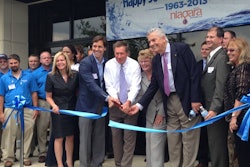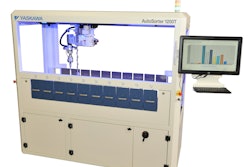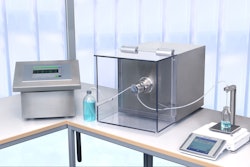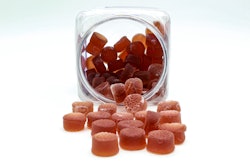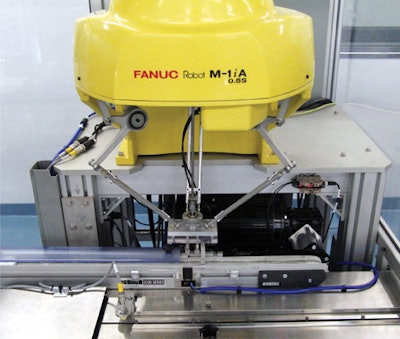
Since 1989, Blacksburg, VA-based TechLab, Inc. has been producing rapid, non-invasive intestinal diagnostic test kits for use by clinical laboratories around the world. In mid-2012, the company opened its second manufacturing and distribution facility in Radford, VA, to keep pace with growing demand for its chemistry test kits. In designing one of the packaging lines in the new facility, TechLab built upon the knowledge it had acquired from its experiences automating its first facility.
“When we first started out, we were packaging all of our products manually,” recalls TechLab production supervisor Steven Lester. “We would have a handful of operators taking the individual components and placing them into preformed packages, and then hand-sealing them, one at a time.”
TechLab’s first foray into automation involved close collaboration with ESS Technologies to introduce one of the first FANUC LR Mate M430 articulated-arm pick-and-place robots into a pharmaceutical-type packaging environment. The robot was used to load parts onto an infeed conveyor that led to an entry-level flow-wrapping machine. This increased TechLab’s packaging line speed to 35 parts/min and reduced labor from seven or eight operators down to two.
By the time the Radford facility was completed, the products packaged on this semi-automated line had experienced “exponential growth,” says Lester, compelling TechLab to further automate the process. In its second generation of automation, TechLab specified the ESS TaskMate robotic infeed loading system, including a FANUC LR Mate 200iC six-axis robot, and a FANUC M-1iA high-speed delta robot. The first robot removes individual diagnostic test kits from a stainless-steel tray and places them on a staging conveyor; once the staging conveyor is full, the second robot picks up parts one at a time and feeds them in proper orientation to a Heritage flow-wrapper from Campbell Wrapper.
The combination of the two robots has more than doubled the packaging line’s speed to 90 parts/min.
Says Lester, “The reason we chose to go with the robotics, especially the little M-1iA pick-and-place, was to minimize the footprint of our facility. There are a multitude of different means you can use to get parts to the infeed of the flow wrapper, but all of them either introduce significant noise or require a substantial footprint in order to load parts at 80 to 90 parts per minute.”
Crucial to the selection of the tray unloading system was its use of FANUC’s iRVision® vision technology. TechLab runs two product types on the same flow-wrapping line. While both products are similar in size, one is deeper. Both are supplied to the line in the same size tray, with one product packed in the tray either in one single layer of 128 parts, or in three layers of 128, separated by slip sheets. The second product is packed in seven rows, separated by dividers, with six parts stacked on top of one another in each row. “So the robot needs to have the vision capabilities to call through different products and know the exact location of the parts [in the trays], and whether there are dividers or slip sheets, and how much product is in the tray,” explains Lester.
Both robots use vacuum end-of-arm tools to minimize damage to the parts. “It’s easier on plastics to have a silicone suction cup as opposed to some form of metal or plastic gripper,” says Lester. “Also, in order to obtain the cycle speeds we needed and to ensure that we have longevity of the tooling, vacuum just made more sense.”
Since installing the automated system in June 2012, TechLab has seen a 10% increase in production over the line used in Blacksburg, while going from five 12-hr shifts to four eight-hour shifts. “To put that into perspective,” says Lester, “with our older machinery, it would take us roughly from eight to 12 hours to process 15,000 devices. Currently we can process 30,000 devices comfortably in an eight-hour workday.
“We have definitely improved the overall efficiency of our process. We have also reduced the number of rejects that we have had, as well as equipment-related downtime. That has really enabled us to keep up with—or actually be slightly ahead of—our manufacturing schedules.”



